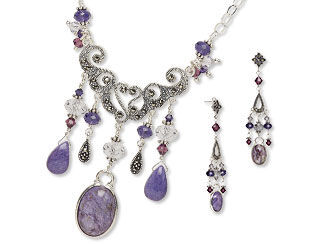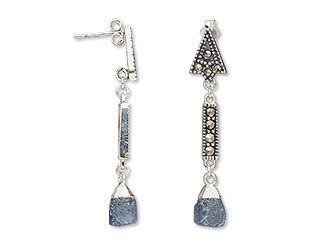What is Marcasite?
Customers love the brilliance of marcasite, but often wonder why the price tag is a little higher for this gemstone. To answer this important question, a little gemology and fashion history is in order.
What exactly IS marcasite? Technically speaking, marcasite is iron sulfide with an orthorhombic crystal structure. Sometimes marcasite is confused for pyrite, since pyrite is iron sulfide with a cubic crystal structure. Both structures have a short bonding distance between the sulfur atoms, but the structures differ in how exactly they bond.
Marcasite is a pale yellow to almost white with a metallic luster. Marcasite is not easily cut and tends to be lighter and more brittle than pyrite. Pyrite is also in abundance compared to marcasite. This has led to many jewelers turning to pyrite for imitation marcasite jewelry in order to make production easier and keep cost down. The extra cost for authentic marcasite is well worth the investment, as marcasite jewelry is a favorite for heirlooms and has been valued since the time of the Incas and Ancient Greeks for its beauty. Even Cleopatra was seen adorned in marcasite stones.
While marcasite's popularity never entirely left, the gemstone saw a new resurgence during the 18th and 19th centuries. Most commonly, marcasite was cut into tiny stones and set into sterling silver. The Gilded Age was especially fond of marcasite and often complimented the tiny stones with a large pearl, diamonds or bold gemstones including emerald, ruby, colored sapphire and more.
Favorite vintage marcasite jewelry produced during the Art Nouveau period is often found in nature-inspired brooches or pendants such as leaves, flowers, butterflies and bees. While this genre of fashion never went entirely out of style, marcasite's popularity saw a boom in the '90s and has remained in a position of prestige. With its nod to romantic Edwardian fashion, the 20th Century couldn't get enough of the vintage appeal, making it high fashion and cementing marcasite's status as timeless.
Today, marcasite is still used as an ideal accent to sterling silver settings. Black gemstones are a favorite to incorporate since the black and silvery white dichotomy is undeniably sophisticated. Pearls are commonly used in conjunction with marcasite ranging from bright white or cream to pastel pinks, antiqued hues or darker burgundy, green, etc.
On a final note, taking care of marcasite stones and jewelry is important to preserve the in-demand shine. This gemstone tends to tarnish quickly when in high humidity and does best in low-humidity storage conditions, especially when paired with anti-tarnish strips. Gently wipe with a very soft, damp cloth and dry with a clean, soft and absorbent cloth. Make sure the piece is entirely dry before wearing or returning to storage. Avoid submersion in water, solutions or bleaches.
Shop for Your Materials Here:
Have a question regarding this project? Email Customer Service.
Copyright Permissions
All works of authorship (articles, videos, tutorials and other creative works) are from the Fire Mountain Gems and Beads® Collection, and permission to copy is granted for non-commercial educational purposes only. All other reproduction requires written permission. For more information, please email copyrightpermission@firemtn.com.









